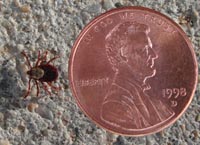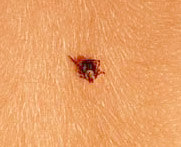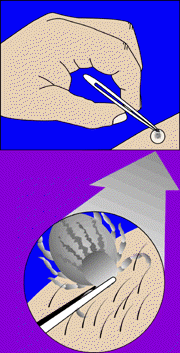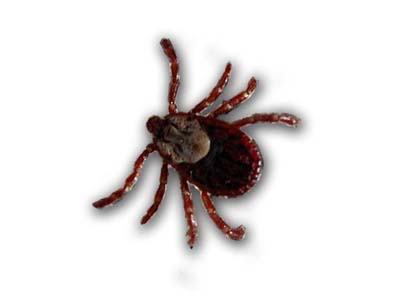One of the more unpleasant aspects
of recreating outdoors is finding a tick on your person after getting
home. Ticks pass diseases on to other animal species, and  there
are many diseases that ticks can carry and pass on to humans. Anyone
who has had tick fever, or has known someone who has had it, knows
how this tiny creature can make your life miserable and the importance
of checking for ticks after outings. Tick fever can bring a healthy,
grown man to their knees feeling deathly ill for two weeks. Under
the most severe cases, kidney failure and death can occur. Ticks
don't attach right away, and once they do and start dining, they
are more easily found because they get so much larger. These little
bugs are not to be taken at all lightly, or the possibility of
getting tick fever dismissed as remote. It is very important to
do full body examination before jumping in the shower at the end
of the day after an outing here in western Wyoming.
there
are many diseases that ticks can carry and pass on to humans. Anyone
who has had tick fever, or has known someone who has had it, knows
how this tiny creature can make your life miserable and the importance
of checking for ticks after outings. Tick fever can bring a healthy,
grown man to their knees feeling deathly ill for two weeks. Under
the most severe cases, kidney failure and death can occur. Ticks
don't attach right away, and once they do and start dining, they
are more easily found because they get so much larger. These little
bugs are not to be taken at all lightly, or the possibility of
getting tick fever dismissed as remote. It is very important to
do full body examination before jumping in the shower at the end
of the day after an outing here in western Wyoming.
Ticks are not insects. They are obligatory
parasites that require blood meals in order to develop. It is important
to remove a tick as soon as possible after detection to minimize
the transmission of diseases.
Ticks are
small and often not felt crawling on your body. They can easily
go undetected for long periods of time, long enough to embed
themselves for a meal and cause trouble. It is important for anyone
recreating outdoors to check themselves, children and pets carefully
for ticks when they get home. Ticks are small and like to hide,
so inspection of hair and every nook and crany on the body is important.
Clothing worn during the outing should be immediately put in the
wash.
Ticks are
known to be disease carriers for:
Rocky
Mountain Spotted Fever
Colorado
Tick Fever
Tularemia
(commonly known as "rabbit fever")
Lyme Disease
Ticks like to crawl up on low vegetation
and wait for people or animals to brush up  against
them. In Wyoming, they are common in the open sagebrush flats and
can be easily picked up by walking through the brush. People walking
through the brush out antler hunting in the spring will likely
come home with an extra tick passenger. Ticks are also common in the
forest. Hikers and fishermen should check for ticks after any outing.
against
them. In Wyoming, they are common in the open sagebrush flats and
can be easily picked up by walking through the brush. People walking
through the brush out antler hunting in the spring will likely
come home with an extra tick passenger. Ticks are also common in the
forest. Hikers and fishermen should check for ticks after any outing.
Ticks become aroused by
the odor and breathing of any nearby host and transfer to humans
or animals by stretching their legs toward the host. Ticks do
not fly or jump but crawl slowly. Ticks seldom attach to hosts
for several hours after contact. Tick season lasts from the onset
of warmer weather in the spring until about mid-July when warmer
weather and low relative humidity cause the ticks to become inactive.
Rocky Mountain Spotted Fever
Rocky Mountain spotted fever is a
serious, generalized infection that is usually spread to people
by the bite of infected ticks. The disease gets its name from the
Rocky Mountain area where it was first identified. Rocky Mountain
spotted fever is found throughout the United States, except in
Maine, Alaska, and Hawaii. Despite the name, few cases are reported
from the Rocky Mountain region. Most cases occur in the southeastern
United States. Rocky Mountain spotted fever is spread by the American
dog tick, the lone-star tick, and the wood tick, all of which like
to live in wooded areas and tall, grassy fields. The disease is
most common in the spring and summer when these ticks are active,
but it can occur anytime during the year when the weather is warm.
Rocky Mountain spotted fever is not spread from person to person,
except rarely by blood transfusion. Symptoms usually begin
3 to 12 days after a tick bite. Without prompt medical care, kidney
failure and shock can lead to death. Rocky Mountain spotted fever
must be treated with antibiotics. Many persons with the disease
need to be hospitalized.
COLORADO TICK FEVER
The disease is limited to the western
U.S. and is most prevalent during March to August during the tick
season. The incubation period is 3 to 6 days. Symptoms of fever
continue for 3 days, then abate and recur 1 to 3 days later for
another few days. Risk factors are recent outdoor activity and
recent tick bite. The incidence is 4 out of 100,000 people.
How to remove a Tick

The best way
to remove a tick is with fine-pointed tweezers. Grab as closely
to the skin as possible and pull straight back, using steady but
gentle force.
- If at all
possible, do not use your fingers to remove the tick.
- It is important
to remove the tick completely, including the mouthpart and the
cement the tick has secreted to secure attachment. Improper tick
removal may cause mouthparts to break off in the skin, possibly
leading to infection.
- Do
not twist the tick, which can cause breakage, leaving
mouth parts in your skin. Twisting
off the head should be avoided, because this may cause
the tick's potentially infectious body fluids to escape. Do
not squeeze, crush, or puncture the body of the tick
because its fluids (saliva, body fluids, gut contents)
may contain infectious organisms.
- Do not crush,
prick, or burn the tick, which may cause it to salivate or
regurgitate infected fluids.
- Do not try
to smother the tick with products such as petroleum jelly or
mineral oil. Ticks can store enough oxygen to complete feeding.
- After removing the tick, thoroughly
disinfect the bite site and wash your hands with soap and water.
- Save the tick for identification
in case you become ill. This may help your doctor make an accurate
diagnosis. Place the tick in a plastic bag and put it in your
freezer. Write the date of the bite on a piece of paper with
a pencil and place it in the bag.
Limiting exposure to ticks is the most
effective way to reduce the likelihood of tick bites. Careful inspection
and removal of crawling or attached ticks is an important method of
preventing tick-borne diseases. It may take several hours of attachment
before organisms are transmitted from the tick to the host.
Folklore remedies, such as the use
of petroleum jelly or hot matches, do little to encourage a tick
to detach from skin. In fact, they may make matters worse by irritating
the tick and stimulating it to release additional saliva or regurgitate
gut
contents, increasing the chances of transmitting
the pathogen. These methods of tick removal should be avoided. A number of
tick removal devices have been marketed, but none are better than a plain set
of fine tipped tweezers.
TICK BITE PRECAUTIONS
- Wear light-colored clothing to
allow you to see ticks that are crawling on your clothing.
- Tuck your pants legs into your
socks so that ticks cannot crawl up the inside of your pants
legs.
- Apply repellants to discourage
tick attachment. Repellents containing permethrin can be sprayed
on boots and clothing, and will last for several days. Repellents
containing DEET (n, n-diethyl-m-toluamide) can be applied to
the skin, but will last only a few hours before reapplication
is necessary. Use DEET with caution on children. Application
of large amounts of DEET on children has been associated with
adverse reactions.
- Conduct a body check upon return
from potentially tick-infested areas by searching your entire
body for ticks.
- Use a hand-held or full-length
mirror to view all parts of your body. Remove any tick you find
on your body.
- Parents should check their children
for ticks, especially in the hair, when returning from potentially
tick-infested areas.
- Additionally, ticks may be carried
into the household on clothing and pets. Both should be
examined carefully.
PROPER DISPOSAL OF
A TICK
Kill the tick by stepping on it.
Place the dead tick in a sealed container or small plastic bag and deposit in
the trash.. Do not flush live ticks down the toilet because they can easily survive
in the water.
Web sites with more information:
US
Food & Drug Administration-Tick Information
Center
of Disease Control-Rocky Mountain Spotted Fever
Pictures
of ticks
Ticks and Livestock in Wyoming


 against
them. In Wyoming, they are common in the open sagebrush flats and
can be easily picked up by walking through the brush. People walking
through the brush out antler hunting in the spring will likely
come home with an extra tick passenger. Ticks are also common in the
forest. Hikers and fishermen should check for ticks after any outing.
against
them. In Wyoming, they are common in the open sagebrush flats and
can be easily picked up by walking through the brush. People walking
through the brush out antler hunting in the spring will likely
come home with an extra tick passenger. Ticks are also common in the
forest. Hikers and fishermen should check for ticks after any outing.
